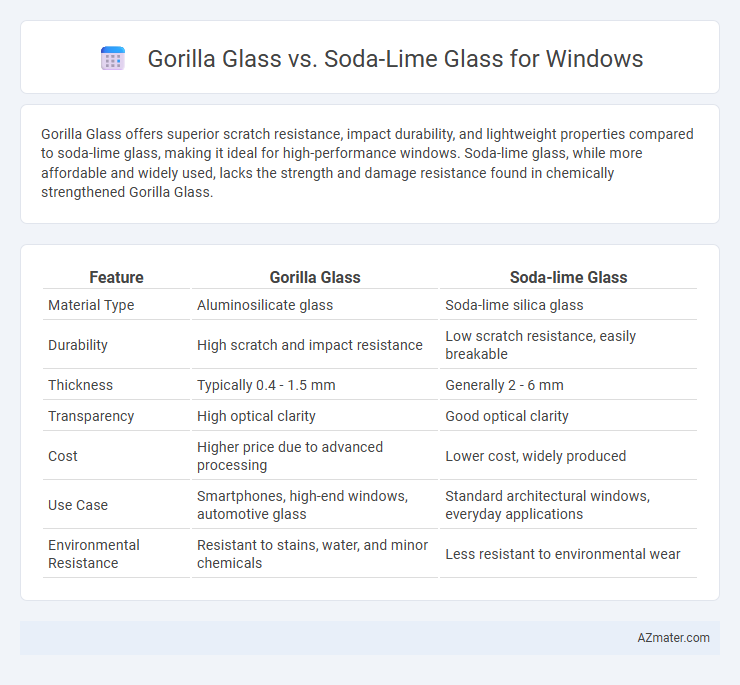Gorilla Glass offers superior scratch resistance, impact durability, and lightweight properties compared to soda-lime glass, making it ideal for high-performance windows. Soda-lime glass, while more affordable and widely used, lacks the strength and damage resistance found in chemically strengthened Gorilla Glass.
Table of Comparison
| Feature | Gorilla Glass | Soda-lime Glass |
|---|---|---|
| Material Type | Aluminosilicate glass | Soda-lime silica glass |
| Durability | High scratch and impact resistance | Low scratch resistance, easily breakable |
| Thickness | Typically 0.4 - 1.5 mm | Generally 2 - 6 mm |
| Transparency | High optical clarity | Good optical clarity |
| Cost | Higher price due to advanced processing | Lower cost, widely produced |
| Use Case | Smartphones, high-end windows, automotive glass | Standard architectural windows, everyday applications |
| Environmental Resistance | Resistant to stains, water, and minor chemicals | Less resistant to environmental wear |
Introduction to Gorilla Glass and Soda-Lime Glass
Gorilla Glass is an alkali-aluminosilicate sheet glass engineered for high durability and scratch resistance, widely used in electronic device screens and specialized windows. Soda-lime glass, composed primarily of silica, soda, and lime, serves as the most common and cost-effective window material with moderate strength and ease of manufacture. The enhanced chemical strengthening process and thin profile of Gorilla Glass provide superior impact resistance compared to the conventional, heavier soda-lime glass.
Composition and Manufacturing Processes
Gorilla Glass is an aluminosilicate glass primarily composed of silica, alumina, and potassium oxide, manufactured through an ion-exchange process that replaces smaller sodium ions with larger potassium ions, enhancing its strength and scratch resistance. Soda-lime glass, mainly made from silica, sodium oxide, and calcium oxide, is produced using a traditional float glass process, which involves melting raw materials and forming the glass by floating it on molten tin. The ion-exchange process in Gorilla Glass results in higher durability and chemical resistance compared to the more brittle and less resistant soda-lime glass used in standard windows.
Strength and Durability Comparison
Gorilla Glass exhibits superior strength and durability compared to soda-lime glass, with its chemically strengthened aluminosilicate composition providing enhanced resistance to scratches and impact. Tested to withstand drops from significant heights without shattering, Gorilla Glass offers a higher level of toughness ideal for windows in high-stress environments. Soda-lime glass, while cost-effective and commonly used, is more prone to breakage and scratches under similar conditions, making it less suitable for applications requiring exceptional durability.
Scratch and Impact Resistance
Gorilla Glass offers superior scratch resistance compared to soda-lime glass due to its chemically strengthened surface, which significantly reduces the likelihood of visible marks from everyday abrasions. In terms of impact resistance, Gorilla Glass outperforms soda-lime glass by absorbing and dispersing energy more effectively, leading to increased durability and a lower chance of shattering upon impact. This enhanced toughness makes Gorilla Glass an ideal choice for windows exposed to harsh environmental conditions or frequent physical contact.
Optical Clarity and Transparency
Gorilla Glass offers superior optical clarity and transparency compared to soda-lime glass due to its chemically strengthened composition, which minimizes distortions and enhances light transmission. Its advanced manufacturing process reduces impurities and defects, resulting in clearer, sharper visual performance ideal for high-precision window applications. In contrast, soda-lime glass often exhibits lower clarity and higher haze because of inherent material impurities and less controlled production methods.
Cost and Availability
Gorilla Glass, known for its high strength and scratch resistance, is significantly more expensive than soda-lime glass, with prices several times higher due to advanced chemical treatments and manufacturing processes. Soda-lime glass, the most common and cost-effective option for windows, benefits from widespread availability and established large-scale production, making it an economical choice for standard window applications. The limited production of Gorilla Glass mainly targets electronics and specialty uses, restricting its availability for typical window installations.
Applications in Windows and Other Industries
Gorilla Glass offers superior scratch resistance, impact durability, and thinness, making it ideal for high-performance windows in smartphones, tablets, and automotive applications where lightweight and strength are crucial. Soda-lime glass, while more cost-effective and easy to manufacture, is commonly used in conventional window panes, architectural glazing, and packaging due to its adequate clarity and mechanical properties. Industries such as consumer electronics, automotive, and aerospace favor Gorilla Glass for advanced protective solutions, whereas construction, interior design, and mass-market products predominantly utilize soda-lime glass for their affordability and versatility.
Environmental Impact and Sustainability
Gorilla Glass offers superior durability and scratch resistance compared to soda-lime glass, reducing the frequency of replacements and minimizing waste. Soda-lime glass production involves higher energy consumption and emits more CO2, while Gorilla Glass manufacturing uses advanced processes that optimize material efficiency and lower environmental footprint. Recycling rates for soda-lime glass are higher, but the longer lifespan and enhanced performance of Gorilla Glass contribute significantly to overall sustainability by extending window replacement cycles.
Maintenance and Lifespan
Gorilla Glass offers superior durability and scratch resistance compared to soda-lime glass, significantly reducing maintenance needs over time. Soda-lime glass is more prone to scratches and chips, leading to more frequent repairs or replacements. The enhanced chemical composition of Gorilla Glass extends its lifespan, making it a more cost-effective choice for long-term window applications.
Which Glass is Better for Windows?
Gorilla Glass offers superior strength and scratch resistance compared to soda-lime glass, making it more durable and long-lasting for window applications. Its chemically strengthened composition enhances impact resistance and reduces the likelihood of breakage, while soda-lime glass is more prone to cracking and scratching under stress. For windows requiring robust protection and longevity, Gorilla Glass is the better choice.

Infographic: Gorilla glass vs Soda-lime glass for Window
 azmater.com
azmater.com